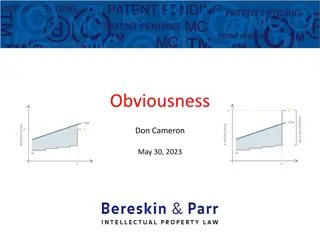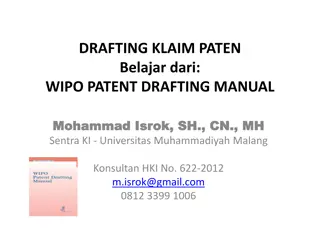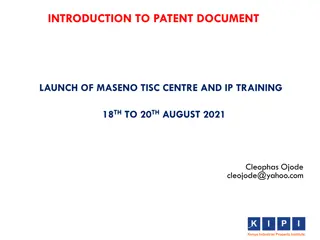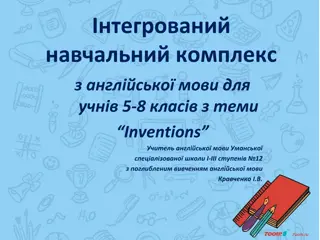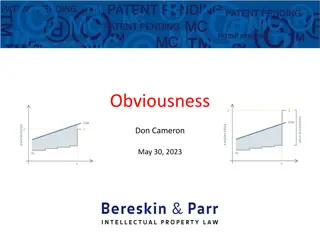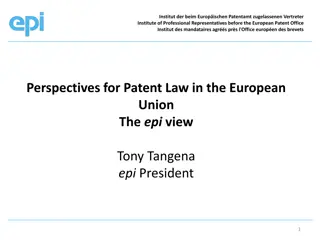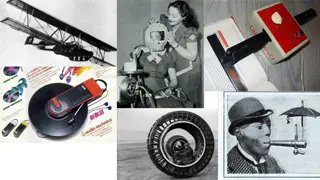Overview of Patent Law & Protecting Inventions
Understanding patent law essentials - what makes an invention patentable, the patent bargain, importance of clear claims, and protecting intellectual property. Insightful quotes by inventors enhance the exploration of patent rights and the importance of precise claims.
Download Presentation

Please find below an Image/Link to download the presentation.
The content on the website is provided AS IS for your information and personal use only. It may not be sold, licensed, or shared on other websites without obtaining consent from the author.If you encounter any issues during the download, it is possible that the publisher has removed the file from their server.
You are allowed to download the files provided on this website for personal or commercial use, subject to the condition that they are used lawfully. All files are the property of their respective owners.
The content on the website is provided AS IS for your information and personal use only. It may not be sold, licensed, or shared on other websites without obtaining consent from the author.
E N D
Presentation Transcript
Introduction to Patent Law Donald M. Cameron 2017 Donald M. Cameron
Patentable inventions To be patentable, an invention must be: 1. New (never been done before, publicly) 2. Useful (it works; does what is promised) 3. Inventive or Non-Obvious (not something any skilled idiot could have done) 2
The Patent Bargain Right to exclude others during the term of the patent Clearly delineate what everyone else is NOT allowed to do Right for everyone else to use the invention once the patent expires Show us NOW: How to make it How to use it The disclosure : An Instruction Manual The claims : I claim my invention to be 3
talk about the words It is a long time since I have attended a gathering of the scientific world a world in which I am at home one in which men deal with realities and where truth is, in fact, the goal. For the past ten years I have been in exile from this world and an explorer in another a world where men substitute words for realities and then talk about the words. Truth in that world seems merely to be the avowed object. Now I undertook to reconcile the objects of these two worlds and for a time I believed that could be accomplished. Perhaps I still believe it or perhaps it is all a dream. Edwin Howard Armstrong, inventor of regeneration and FM radio, in an address to the annual convention of the Institute of Radio Engineers, Philadelphia, U.S.A., May 29, 1934 quoted by Tom Lewis in Empire of the Air, The Men Who Made Radio ; Edward Burlingame Books, 1991, referring to his losses in the hands of the U.S. judicial system. 4
Staking a Claim "By his claims the inventor puts fences around the fields of his monopoly and warns the public against trespassing on his property. His fences must be clearly placed in order to give the necessary warning and he must not fence in any property that is not his own. The terms of a claim must be free from avoidable ambiguity or obscurity and must not be flexible; they must be clear and precise so that the public will be able to know not only where it must not trespass by where it may safely go. If a claim does not satisfy these requirements it cannot stand... The inventor may make his claims as narrow as he pleases within the limits of his invention but he must not make them too broad. He must not claim what he has not invented for thereby he would be fencing off property which does not belong to him. It follows that a claim must fail if, in addition to claiming what is new and useful, it also claims something that is old or something that is useless. Minerals Separation North American Corp. v. Noranda Mines, Ltd., (1947), 12 C.P.R. 99 (Ex.Ct. per Thorson P.) at p. 146. 5
Whats the best way to protect a castle s treasures? Answer: Nested fortifications: a moat, surrounding a wall, surrounding another wall, surrounding the central building 6
Prof. Carl Moys dicta: Stay off the fresh grass 1. 2. Do not run on the new grass. Do not put your feet on the new grass. Do nothing that will impair the growth of the new grass. 3. Lesson to be learned: If you are too specific, people will figure out a way around your language and will do what you don t want them to do. 7
Sets and Subsets 1. Do nothing that will impair the growth of the new grass. 2. Do not put your feet on the new grass. 3. Do not run on the new grass. 1 2 3 8
The Disclosure What parts do I need? How do they fit together? How do I operate it? 9
Setting the Stage The Intro The field of art to which the invention pertains includes the field of ships, particularly sailboats and iceboats, and the field of land vehicle sail attachments. Sail propulsion has been suggested as a motive means not only for boats and iceboats, but also for such watercraft as surfboards and land craft such as skateboards and sleds, i.e., generally any lightweight small craft. Typically, a sail is provided on a mast that is rigidly secured to the craft in a vertical position or else the sail and mast are entwined in a network of riggings and control mechanisms. The general effect of providing a sail on a normally sail-free vehicle is to convert the vehicle into a water- or land-boat. Thus, by rigidly securing a sail to a surfboard, the feel of the surfboard and enjoyment as such is lost and the skill normally required to control it is no longer needed. Instead one obtains the speed and feel of a light sailboat and needs substantially only those skills appropriate to control a sailboat. The same "denaturing" occurs with other vehicles modified to bear a sail. A further problem arises when a sail is fitted to a vehicle that does not have high roll stability in that sudden or excessive winds can overturn the vehicle. A need therefore exists for safely providing wind-propulsion means for a vehicle not normally so equipped but which means preserves the original ride and control characteristics of the vehicle. 11
The Consistory Clause The present invention provides wind propulsion means for a vehicle that adds new dimensions of wind responsiveness and speed and yet enhances the vehicle s normal ride and control characteristics to greatly increase the enjoyment obtained therefrom. Wind-propelled apparatus is provided comprising vehicle body means adapted to support a user and wind- propulsion means pivotally associated with the body means and adapted to receive wind for motive power. The position of the propulsion means is controllable by the user and is substantially free from pivotal restraint in the absence of such control. 12
General Statement of the Invention In particular embodiments, the propulsion means is connected to the vehicle body by means of a universal joint, e.g. a joint having three axes of rotation, or other such joint to enable the propulsion means to be substantially free-floating in the absence of user control. The wind propulsion means can comprise a spar pivotally attached to the vehicle body and a sail on the spar. Means are provided to allow the user to grasp the sail on one or both sides thereof. Thus, a boom is provided laterally disposed on the spar to hold the sail taut and provide a hand-hold. In particular embodiments, a pair of booms is provided arcuately connected athwart the spar and securing the said therebetween. The invention can be used on watercraft, iceboats and land craft. It can be used on small yachts, runabouts, canoes, rowboats and other such craft, but is most advantageously used on small and lightweight vehicles such as surfboards, iceboats, skateboards and sleds. Leeboard means can be provided for a watercraft of low roll stability such as a surfboard. The term "leeboard" is means to include center boards and dagger-boards, as these terms are known to the sailing art, as well as other projections from the body of the craft, planar or otherwise extending into or onto the water for stabilization. The present invention allows essentially all of the steering and control to be accomplished through the sail; i.e. no rudder or other steering mechanism is needed, although such need not be excluded. One may accelerate, turn and tack merely by manipulating the sail. However, because the said is pivotally unrestrained, it must be held by the user with the user relying on his skill with the vehicle for balance. In the event of sudden or excessive winds, the user need only release the sail and it will immediately fall in any direction, freeing the vehicle from the propulsive force. 13
Introducing the Diagrams FIGURE 1 is a perspective view of a wind- propelled apparatus according to an embodiment of this invention, obtained by modifying a surfboard with a sail, spar and boom therefor and leeboard; FIGURE 2 is a sectional view, on line 2-2 of FIGURE 1, of a universal joint used for pivotal motion of the sail; FIGURE 3 is a sectional view, on lines 3-3 of FIGURE 1, of the spar-side juncture between the booms; and FIGURE 4 is a sectional view, on line 4-4 of FIGURE 1, of the clew-side juncture between the booms. 14
How to make it Referring to FIGURE 1, a wind-propelled apparatus is shown, including a surfboard 10, spar 12, triangular sail 14 and booms 16 and 18. The surfboard 10 has a dagger-board 20, as leeboard, inserted through an opening 22 provided in the body of the surfboard 10 and projecting obliquely from the bottom 24 thereof. A top portion of the dagger-board 20 extends somewhat beyond the top surface 28 of the surfboard 10 to provide a platform 29 for pivotal attachment of the spar 12 as will be more fully described below. The spar 12 is a stout, rounded, elongated fiberglass shaft which, in this case, is hollow for lightness but may be of solid wood or metal, and has a cylindrical wood base 27 wedged through its lower end. The spar 12 serves as a pivotal mast for the sail 14 and is inserted within a hem 30 tapering along a long edge 31 of the sail 14 toward the top thereof. The bottom of the sail 14 is secured to the spar 12 by a rope 32 threaded through an eyelet 34 in a lower edge of the sail 14 adjacent to the spar 12. 15
How to make it, contd Referring to FIGURE 2, the spar 12 is connected to the dagger-board platform 29 by means of a three-axis universal joint 36. The joint 36 is made completely of stainless steel and is attached to the spar by means of brace plates 38 and 40 held on opposite sides of the spar base 27 by wood screws 37. The brace plates 38 and 40 have extended portions 42 and 44, respectively, somewhat below the spar base 27 and disposed on opposite sides of a short section of stainless steel tubing 46. A one-quarter inch diameter headed pin 48 extends through holes 50 and 52 in the brace plate extensions 42 and 44 and is rotatably secured by a cotter pin 54 inserted through a cotterway 56 in the headed pin 48. A U-shaped clevis 58 of stainless steel sheeting is disposed on the tubing 46 so that its sides 60 (only one of which is shown) lie below and transverse to the brace plate extensions 42 and 44. A -inch diameter headed pin 62 (shown in cross-section in FIGURE 2) extends through holes 64 in the clevis sides and in the tubing 46 and is rotatably secured by a cotter pin (not shown) through a cotterway in the headed pin 62. A three-inch long, -inch diameter round head machine screw 68 rotatably secures the clevis 58 to the dagger-board 20 by extending through a hole 70 in the base 71 of the clevis 58 and from there through a washer 72 and underlying nut 74 and locknut 76 set in a mortise 78 in the dagger-board platform 29. The machine screw 68 holds the base of the clevis 58 with sufficient play to allow sliding rotation of the clevis 58 against the washer 72. 16
How to make it, contd Referring to FIGURES 1 and 3, a pair of curved, laminated wood booms 16 and 18 are provided about four feet from the surface 28 of the surfboard 10 and are arcuately connected at both their ends. At the spar-end, the booms are connected together and to the spar 12 by a loop of one- inch wide webbed tape 80 encircling the spar 12 through a crescent shaped opening 82 in the said hem 30. The tape loop 80 has brass rings 84 at its ends held in place by stitches 86 through the looped tape and which secure the tape 80 to the booms 16 and 18 by engagement with brass hook fittings 88 secured to the booms 16 and by wood screws 90. Referring to FIGURES 1 and 4, the booms 16 and 18 are provided at their clew ends with outhaul openings 92 and 94, respectively, and jamb cleats 96 and 98, respectively, which are secured to the booms 16 and 18 by screws 99. An outhaul 100 is threaded from the jamb cleat 98 of one boom 18 through the outhaul opening 94 in that boom 18, through a reinforced opening 102 in the sail slew 104, through the outhaul opening 92 in the second boom 16, looped through both outhaul openings 94 and 92 and from there to a second jamb cleat 96 on the other boom 16. The outhaul 100 is then pulled taut and secured by the second jamb cleat 96 to hold the sail 14 between the booms 16 and 18. 17
How to use it In operation, the user stands on the top 28 of the surfboard 10 behind the point where the spar 12 is attached by the universal joint 36 and grips one or the other of the booms 16 and 18. If he were going before the wind and wished to make a turn, he would tilt the sail 14 forward, thus applying the force of the wind to the nose of the surfboard 10 and causing the board 10 to turn to the left or right depending on which side of the sail 14 was windward. On the other hand, if he wanted to come about into the wind for the purpose to tacking, he would pull the sail 14 backwardly to apply the force of the wind to the rear of the board 10, causing the rear of the board 10 to move so as to come into the wind. As he is into the wind, he may complete the tack by merely walking in front of the sail 14, grasping the boom on the other side and setting the sail 14 so that the wind captures it and the board 10 is then on its new course. The sail may be maneuvered forward and backward for speed control. In the event that a sudden surge of wind threatens to capsize the surfboard 10, the user may merely release the sail 14 and it will fall free into the water, completely removing the danger. The sail 14 is provided at its spar 12 end with a rope 106 so that the user can readily pull the sail 14 back into sailing position. 18
Concluding Lines It will be understood that modifications and variations may be effected to adapt the foregoing apparatus for the expediencies of particular applications without departing from the scope of the novel concepts of this invention. 19
The Claims The embodiments of the invention in which an exclusive property or privilege is claimed are defined as follows: 1. Wind-propelled apparatus comprising body means adapted to support a user and wind- propulsion means pivotally associated with said body means and adapted to receive wind for motive power for said apparatus, said propulsion means comprising a mast, a joint for mounting said mast on said body means, a sail and means for extending said sail laterally from said mast, the position of said propulsion means being controllable by said user, said propulsion means being substantially free from pivotal restraint in the absence of said user, said joint having a plurality of axes of rotation whereby said sail free falls along any of a plurality of vertical planes upon release by said user. 2. The apparatus of Claim 1 wherein said propulsion means is adapted to be hand-held by said user but is otherwise substantially free from pivotal restraint. 3. The apparatus of Claim 1 including means for said user to hold said sail. 4. The apparatus of Claim 1 wherein said sail extending means comprises a boom laterally disposed of said mast to hold said sail taut and adapted to provide a hand-hold for said user. 20
The Claims, contd 5. The apparatus of Claim 1 including means adapted to enable said user to grasp either side of said sail. 6. The apparatus of Claim 1 adapted as a watercraft. 7. The apparatus of Claim 6 including water stabilizing means associated with said body means. 8. The apparatus of Claim 6 including leeboard means associated with said body means. 9. The apparatus of Claim 1 wherein said propulsion means is substantially the sole means for changing the direction of travel of said apparatus. 10. The apparatus of Claim 4, wherein said boom comprises a pair of boom members arcuately connected athwart said mast and securing said sail therebetween. 21
Claim chart - hierarchy 1. Wind propelled apparatus 2 prop means is hand-held 4 lateral boom holds sail / hand hold 5 means to grasp either side of sail 9 propulsion sole means to steer 3 user can hold sail 6 water craft 10 pair of boom members (wishbone) 7 water stabilizing means 8 - leeboard 22
The Sailboard patent 1. Wind propelled apparatus means for extending said sail laterally from said mast 4. said sail extending means comprises a boom laterally disposed of said mast to hold said sail taut and adapted to provide a hand-hold for said user 10. said boom comprises a pair of boom members arcuately connected athwart said mast and securing said sail therebetween 1 4 10 23
Take Aways 1. Patents protect new, useful and inventive inventions 2. Patents are a bargain: 1. Inventors/Owners get a limited monopoly 2. Public gets to make & use invention after patent expires 3. Patents have 2 main parts: claims and a disclosure 1. The Claims define the fence around the monopoly. You can have many fences. They are hard to draft well. 2. The Disclosure is a manual telling you how to make and use the invention. It should be complete. 24
Introduction to Patent Law Donald M. Cameron 2014 Donald M. Cameron



